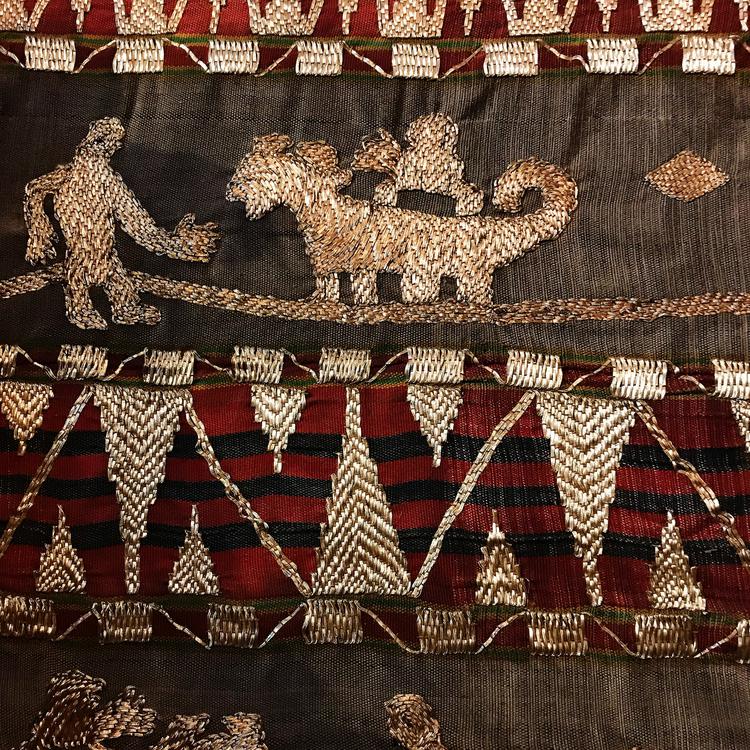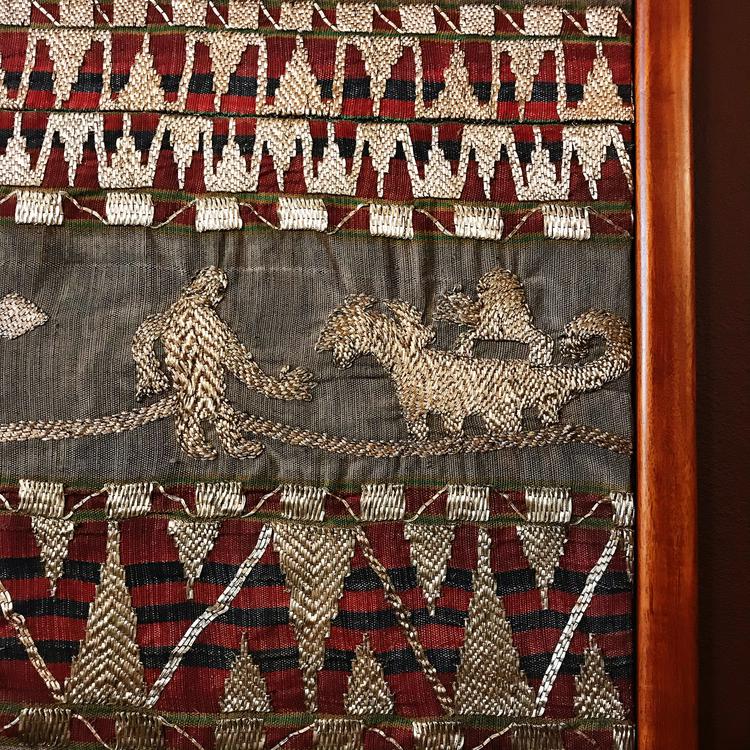Sumatran Lampung Tapis Raja Medal Sarong
Sumatran Lampung Tapis Raja Medal Sarong
Couldn't load pickup availability
Pubian people, early 19th century, Lampung, Sumatra, Indonesia.
Absolutely gorgeous old ceremonial skirt, tapis raja medal, with alternating bands of different shades of indigo blue, Indian red, green and burnt yellow. Embroidered with warped and couched silver thread. Broad bands filled with images of mythological creatures (naga) and, in alternate rows, nagas with people riding on them. Naga are associated with water, fertility, the moon, and the Milky Way, thus, successful transitions and voyages often were symbolized by naga. It is a full tapis skirt but the seam that allowed the textile to be worn as a skirt has been opened for display purposes. Lampung is a vast territory that lies below Palembang at the southernmost tip of Sumatra. The term "Lampung" is actually a generic term and refers to three ethnic groups: The Abung (Abung Siwo Mego), a people that inhabited the mountains in the north of the province; The Pubian (Pubian Telu Suku), from the eastern lowlands (when grouped together, are also referred to as Pepadun) and the Paminggir, who lived along the southern coasts (Saibatin group). The three groups consider themselves related to one another.
The women of Lampung developed a rich variety of textiles that included ceremonial forms as well as other types, which were used as clothing. Traditionally, the heavily embroidered tapis is worn as a sarong for weddings, festivities including the week leading up to the end of Muslim Fasting month (Idul Fitri), and welcoming ceremonies. The embroidery of its major design features distinguishes it from women's sarongs elsewhere in Indonesia. Meticulously woven (the weaving process is called mattakh) textiles were decorated with mica, glass, polychrome silk and predominantly metallic gold or silver wrapped threads attached and held in place with decorative stitches on the underside, using a technique called "sasab". Some old tapis (called tapis tua), are covered entirely in golden embroidery. Ornamentation exist on a piece of tapis symbolize a form of Lampung public confidence towards the grandeur of nature and the greatness of God. Traditionally using floral motifs, it has numerous variations. The word "pucuk rebung" means bamboo shoot and its elongated triangle is a common motif found in the designs of the Lampung tapis. Other designs may include snakes, elephants, birds, ships, and various mythical creatures.
Colours can vary depending on the region in which the tapis is made, and can take several months to complete, depending on the complexity of the pattern and the amount of gold or silver thread. Traditional textile colours came from nature. For red colorant, they used sepang (Caesalpinia sappan), tamarind (Tamarindus indica), areca nut (Areca catechu) and henna (Lawsonia inermis). The turmeric (Curcuma longa) and tamarind (Tamarindus indica) was used for yellow. Rambutan (Nephelium lappaceum) was used to obtain black dye. Durian (Durio zibethnius) was used for brown and indigo (Indigofera tinctoria) and the lanson fruit (Lansium parasiticum) for the blue. To preserve yarn, they used the roots of the fragrant citronella grass (Cymbopogon nardus). Then, to avoid discoloring, they used betel leaves (Piper betle).
Fantastic, imposing tapis raja medal (King’s Badge Tapis) has a traditional pucuk rebung motif with mythological naga and human figures. Excellent condition. Tapis is carefully stretched into modern, double-sided frames. Age-related light wear and faded colours. Thread loss, slight tarnishing, stains and loose threads. Size approx. 126,0cm x 110,0cm (including modern frames).
Provenance: Finnish private collection
NB! We don't ship this item. Pick-up from the shop.
For a similar examples see:
Tapis, The East Indies Museum, Accession Number: 49-737-508 (http://eastindiesmuseum.com/textiles/komering_lampung/49-737-508.html)
Tapis Raja Medal, Art Gallery of NSW, Sydney, Australia, Accession Number 237.2006 (https://www.artgallery.nsw.gov.au/collection/works/237.2006/#about)
References and further reading:
Textiles of Southeast Asia, Transition, Trade and Transformation, Robyn Maxwell, Australia: Oxford University Press, 1990, p. 113.
Traditional Indonesian Textiles, John Gillow, Thames & Hudson, 1995.
Wearing Wealth and Styling Identity: Tapis from Lampung, South Sumatra, Indonesia, Mary Louise Totton, Hood Museum of Art, 2009.
The ship textiles of South Sumatra: functions and design system, Mattiebelle S. Gittinger, Bijdragen tot de Taal-, Land- en Volkenkunde, 1976, 132 (2/3): 207–227.
Sumatra, Crossroads of Cultures, Ed by Francine Brinkgreve & Retno Sulistianingsih, KITLV Press, 2009.
Splendid Symbols: Textiles and Tradition in Indonesia, Mattiebelle S. Gittinger, Washington DC: The Textile Museum, 1979, p. 157.




-
Shipping
The shipment will be prepared in the course of 3-5 days and dispatched via Posti Group Oyj or purchased item(s) can be picked up from our shop during the store's opening hours (Tarkk’ampujankatu 4, 00140, Helsinki, Finland). Within the Finland, all items are shipped via Posti Group Oyj unless otherwise requested. We pack the items carefully and mainly in recycled materials because we want to save nature. You will receive the tracking number for your items by e-mail.
-
Returns
Returns and exchange will be accepted within fourteen days (14) of receipt at the purchaser’s cost to include freight and packaging. Items must be returned in the same condition as when they were shipped, and will not be accepted if damaged or altered in any way. Please inform us via email (info@gotanmaailma.fi) or by calling +358408408352 before sending. We do not accept returns more than 14 days after delivery.




